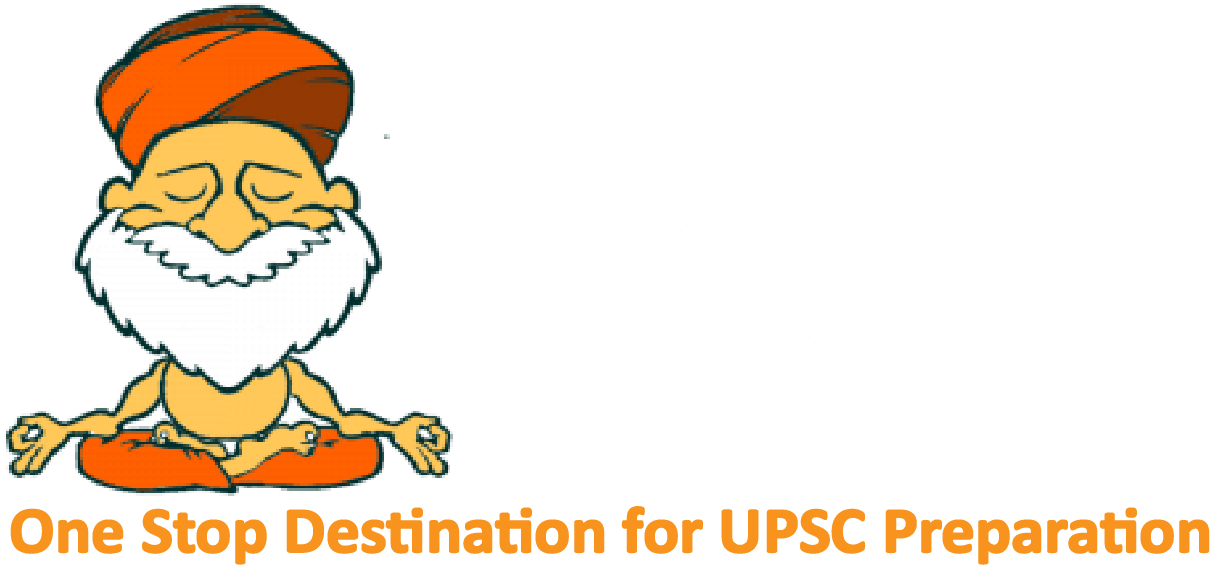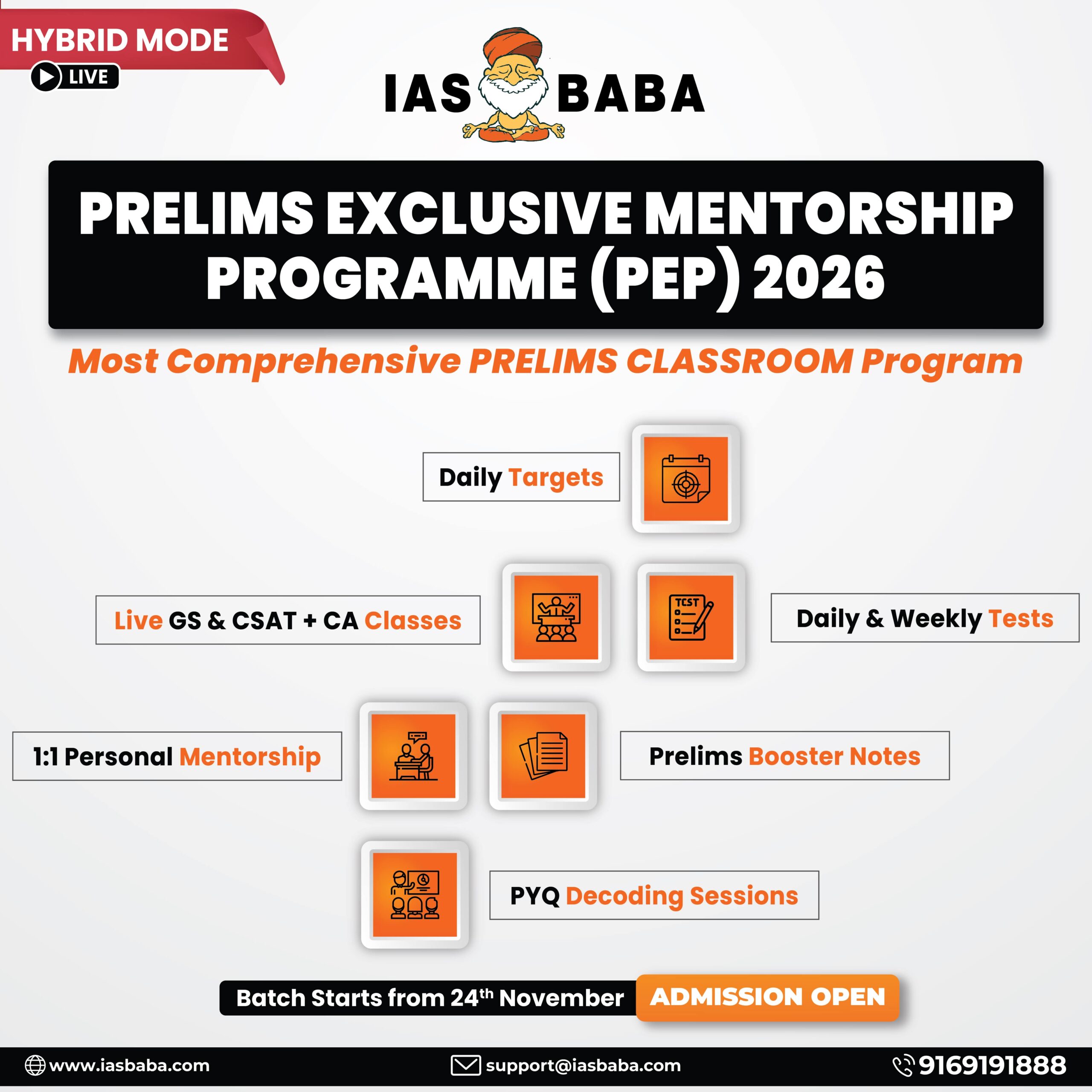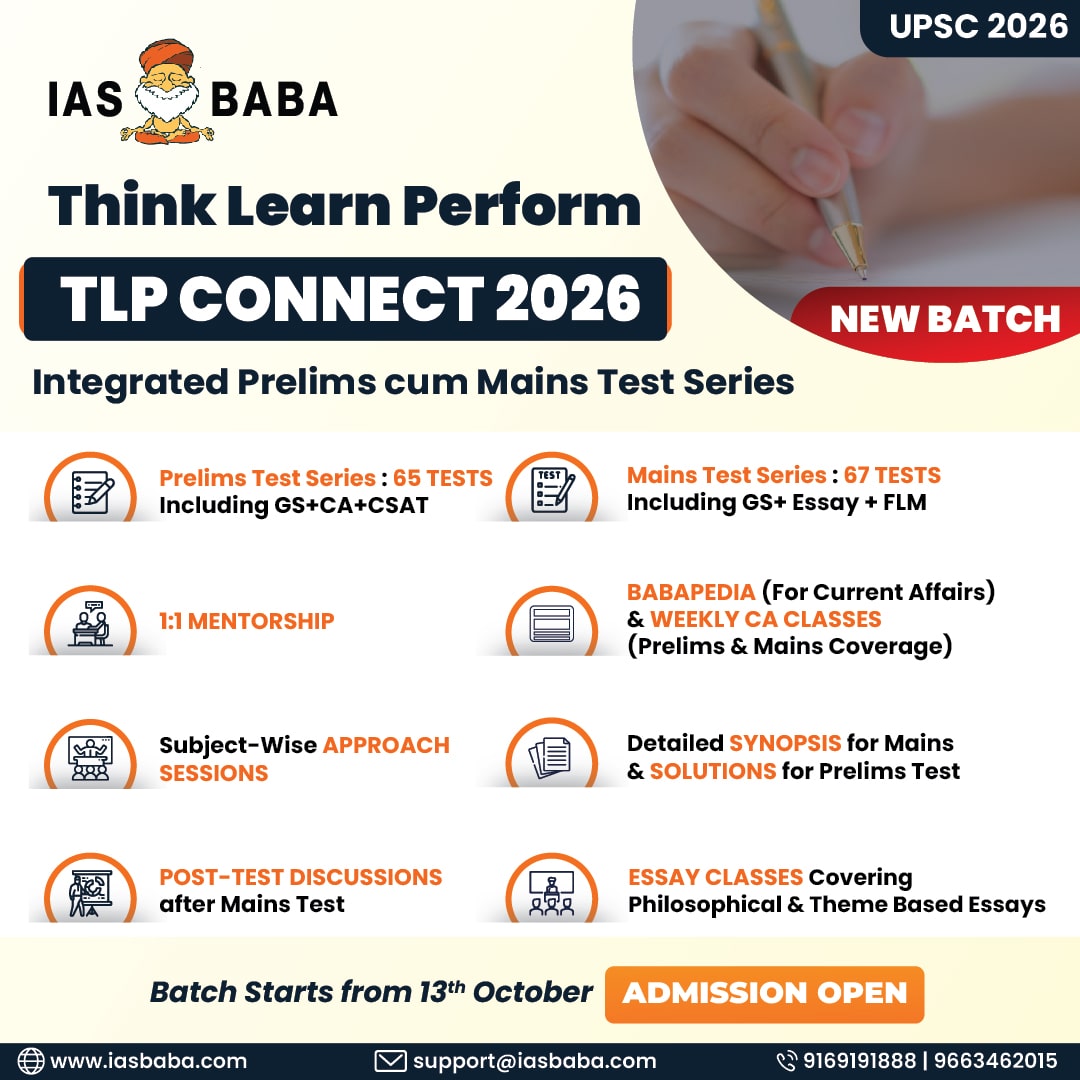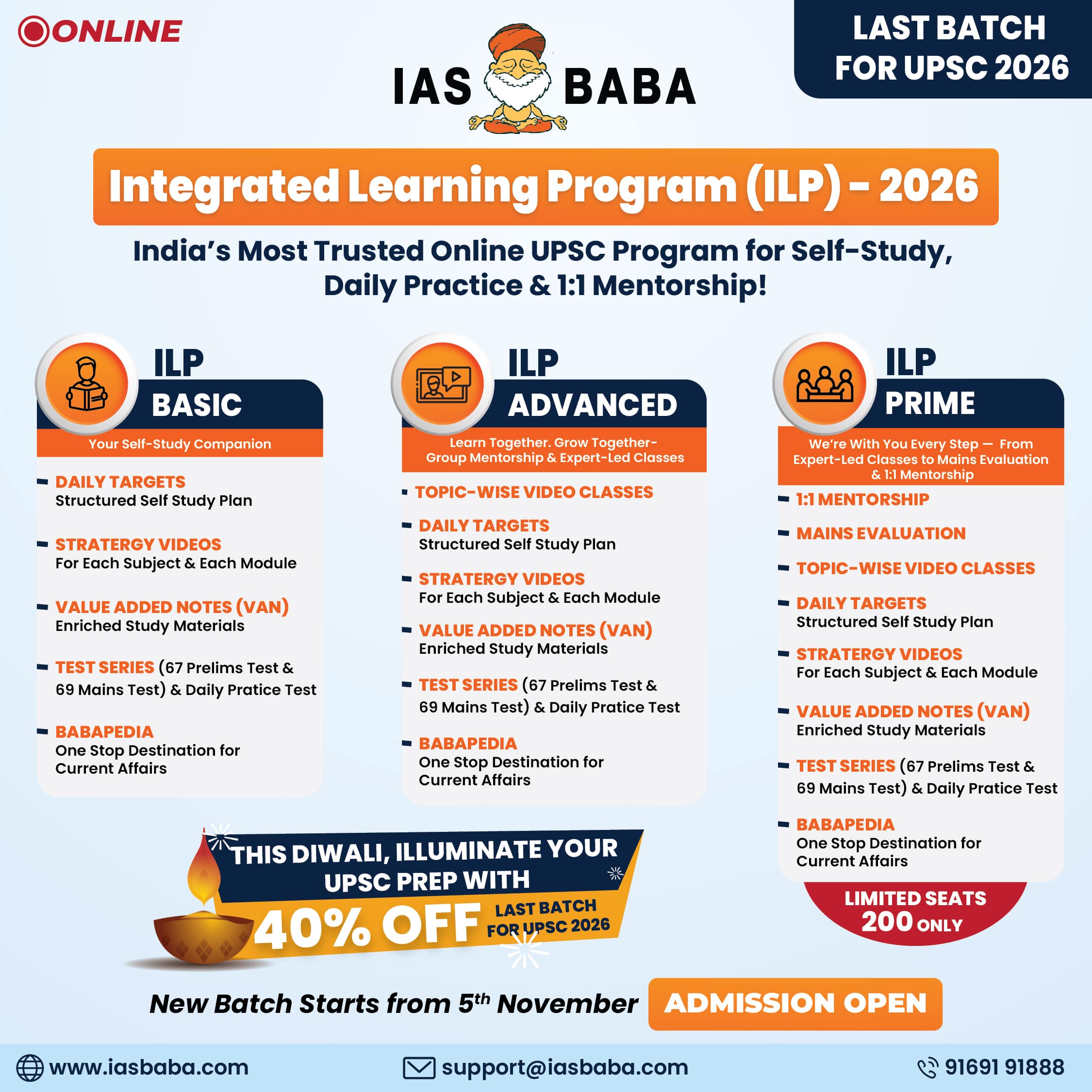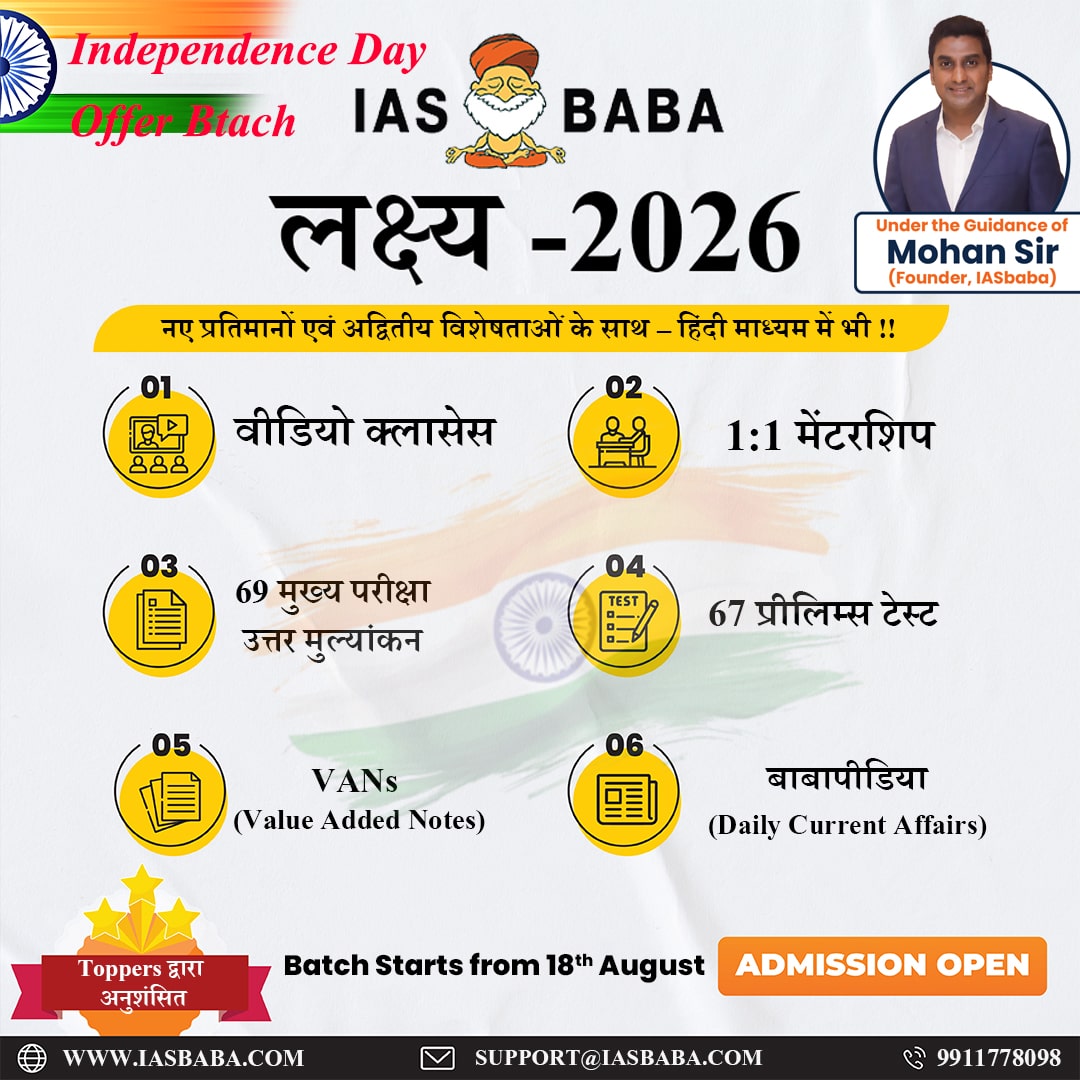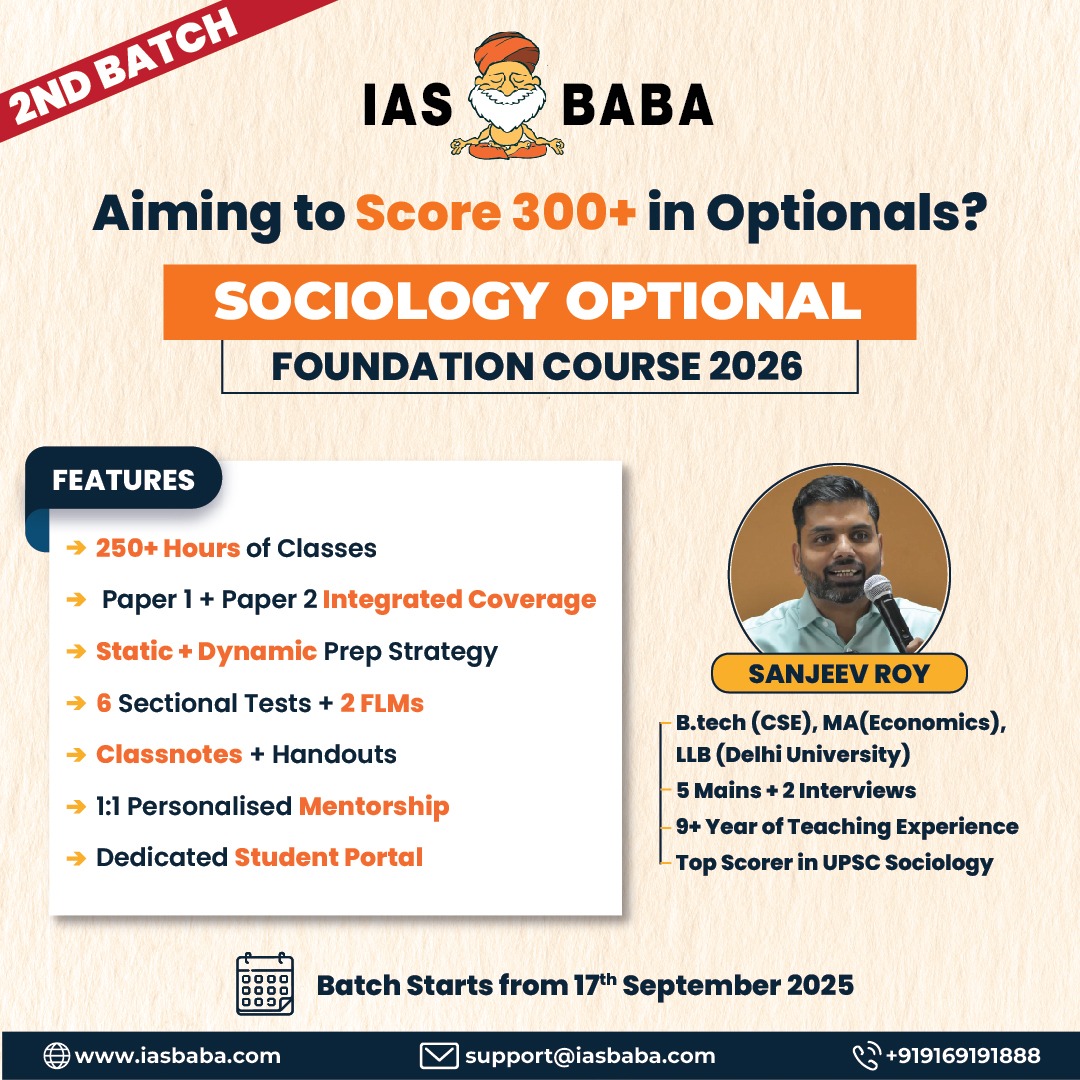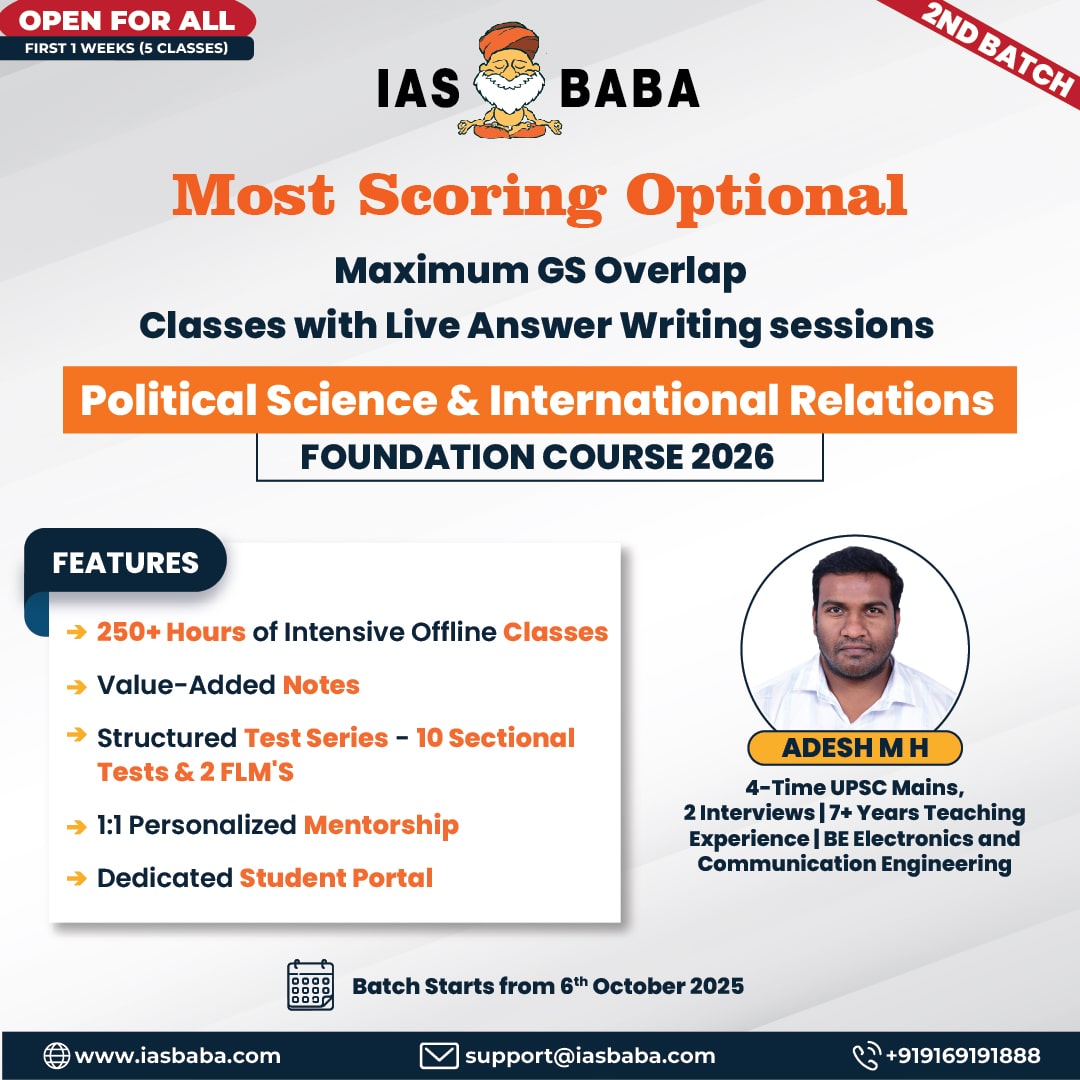IASbaba's Daily Current Affairs Analysis
Archives
(PRELIMS & MAINS Focus)
Category: POLITY
Context: President Droupadi Murmu, has made a reference to the Supreme Court, under Article 143 of the Constitution, on certain questions of law and has sought its opinion on those questions.
Decoding the context: The present reference has raised 14 questions, primarily surrounding the interpretation of Articles 200 and 201, for the court’s opinion.
Learning Corner:
Article 143 – Advisory Jurisdiction of the Supreme Court
- Article 143(1): The President may refer any question of law or fact of public importance to the Supreme Court for its advisory opinion.
- Article 143(2): In matters related to disputes arising out of pre-Constitution treaties or agreements, reference must be made to the Supreme Court.
Key Features:
- Reference is made by the President but based on advice of the Council of Ministers (Article 74).
- The Supreme Court may refuse to give an opinion. However, out of the references made till date, the court has declined to provide its opinion for only one reference in 1993 with respect to the Ram Janmabhoomi case.
- Opinion is not binding on the President or other courts, but it carries persuasive value.
- As per Article 145(3), such a reference must be heard by a Bench of at least five judges.
Historical Context
- The advisory jurisdiction of the Supreme Court under Article 143 is a relic of the Government of India Act, 1935– Governor-General had similar powers.
- A similar provision is available in the Canadian constitution. This mechanism allows the Supreme Court of Canada to offer opinions on legal questions referred to it by the federal or provincial governments.
- In contrast, the U.S. Supreme Court does not entertain advisory opinions due to strict separation of powers.
Current Presidential Reference – Triggered by a recent SC judgment that:
- Prescribed timelines for the President and Governors to act on State Bills.
- 14 questions referred by the President including:
- Interpretation of Articles 200 & 201 (Governor’s powers on assent).
- Whether SC can mandate timelines not explicitly in the Constitution.
- Whether such actions are justiciable before the Bill becomes law.
- Scope of SC’s power under Article 142.
Source : The Hindu
Category: ECONOMY
Context: NSE chief Ashishkumar Chauhan, Finance Minister Nirmala Sitharaman and Chief Economic Advisor V. Anantha Nageswaran have all flagged the growing risk of F&Os and cautioned against trading in derivatives.
Decoding the context: Former SEBI Chairperson Madhabi Puri Buch said she was “confused and surprised” at investors’ interest in F&Os [futures and options] despite 90% of the individuals who invested in them losing money.
Learning Corner:
- A derivative is a financial contract whose value is derived from an underlying asset.
- Common underlying assets: Stocks, indices, commodities (e.g., gold, crude oil), currencies, etc.
- Purpose: Hedging, speculation, or arbitrage.
Types of Derivatives (F&O)
- Futures Contracts: Obligatory contract for both buyer and seller to buy/sell an asset at a predetermined price on a future date.
- Used to speculate or hedge future price movements.
- Unlimited profit/loss potential.
- Example: Buy Natural Gas futures at ₹100/unit for expiry after 3 months.
- Options Contracts: Give the right, not obligation to buy/sell an asset at a specified price before the expiry.
- Two types:
- Call Option – Right to buy.
- Put Option – Right to sell.
- Buyer pays a premium; maximum loss = premium.
- Two types:
Why Are Derivatives Risky?
- Leverage Risk:
- Allows large trades with small margin money.
- Small adverse price movement = massive loss.
- Leverage magnifies both profits and losses.
- Not a Long-Term Asset:
- No ownership of the underlying asset.
- No growth or dividends like equities.
- Lack of Investor Awareness:
- Most retail traders enter without proper knowledge.
- Speculation > Hedging → High risk of capital erosion.
Source : The Hindu
Category: GEOGRAPHY
Context: Amid a downturn in India’s relationship with Bangladesh, the long-delayed Kaladan Multi Modal Transit Transport Project (KMMTTP) linking Mizoram to Kolkata via Myanmar has grown in importance.
Decoding the context: The Ministry of Road Transport and Highways (MoRTH) has now okayed a 166.8-km four-lane highway from Shillong to Silchar, which will eventually be extended to Zorinpui, Mizoram, and connect the KMMTTP with a high-speed road corridor that runs through the heart of the Northeast.
Learning Corner:
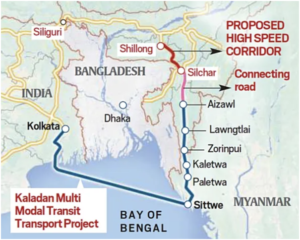
Kaladan Multi-Modal Transit Transport Project (KMMTTP)
- A strategic multi-modal transport corridor connecting Kolkata to Mizoram via Myanmar.
- Signed: 2008 between India and Myanmar.
- Aim: To provide an alternative route to India’s Northeast bypassing the Siliguri Corridor (Chicken’s Neck) and reducing dependence on Bangladesh.
- Part of India’s Act East Policy (earlier Look East Policy).
Strategic Importance
- Bypasses Bangladesh amid strained bilateral ties (especially post-Hasina government ouster).
- Reduces distance between Kolkata and Mizoram by 1,000 km, cutting travel time by 3–4 days.
- Helps connect the landlocked Northeast to seaports.
- Reduces Dependence on Chicken’s Neck i.e. Siliguri Corridor (20 km wide) which is India’s only land route to the Northeast.
Recent Developments
- MoRTH approval (2024-25): 166.8-km Shillong–Silchar four-lane highway, to be extended to Zorinpui (Mizoram).
- Objective: Integrate with the KMMTTP and establish a high-speed corridor from Shillong to the Myanmar border.
| Segment | Mode | Distance | Status |
| Kolkata to Sittwe (Myanmar) | Sea | 539 km | ✅ Completed |
| Sittwe to Paletwa | Inland Waterway (Kaladan River) | 158 km | ✅ Completed |
| Paletwa to Zorinpui (India-Myanmar Border) | Road | 108 km | ❌ Incomplete (last ~50 km pending) |
| Zorinpui to Aizawl & Shillong (via Silchar) | Highway | ~400+ km | ✅ Existing & further extension approved |
Source : The Hindu
Category: GEOGRAPHY
Context: The Jharkhand High Court directed the state government to enforce a pre-existing ban on the consumption and sale of meat, alcohol, and other intoxicants on a hill considered to be sacred by both the Santal Adivasi and Jain communities.
Decoding the context: Referred to as Marang Buru by Santals and Parasnath by Jains, the hill in Jharkhand’s Giridih district has been the site of a century-old inter-community conflict.
Learning Corner:
Parasnath / Marang Buru Hill
- Located in Giridih district, Jharkhand
- Highest peak in Jharkhand (~1,365 m)
- Lies within Parasnath Wildlife Sanctuary
Religious Significance:
- For Jains:
- Known as Parasnath Hill.
- Believed that 20 of 24 Jain Tirthankaras attained moksha (nirvana) here.
- Named after Parshvanatha, the 23rd Tirthankara.
- Follows strict vegetarianism, opposes animal killing (e.g. during Sendra festival).
- For Santals (Tribal/Adivasi):
- Known as Marang Buru (Great Mountain), supreme deity in Santal animist faith.
- The Jug Jaher Than (sacred grove) on the hill is the most sacred dhorom garh (religious site) of the Santals.
- Also significant is the Dishom Manjhi Than on the hill, the symbolic seat of the dishom manjhi (the traditional Santal leader) where customary rituals are performed.
- The Lo Bir Baisi, a tribal council that resolves disputes convenes at Boda Darha in Sohraiya village, on the eastern part of the mountain. It was with a resolution of this council that the historic Santal Hul was launched in 1855. Led by Sidhu and Kanhu Murmu, the rebellion targeted the oppressive dikus, literally “outsiders”, including zamindars, mahajans, and British officials.
Conflict:
- Sendra festival has been a flash point in the Santal-Jain conflict over the hill. During the three-day-long Sendra, all male members of the Santal community head into the forest to hunt. For Jains, who follow a rigorous spiritually-motivated vegetarian diet, Sendra has long caused consternation.
- In 1972, the year in which the Indira Gandhi government passed the Wildlife Protection Act, Adivasi villages around Marang Buru lost their status under the Fifth Schedule of the Constitution.
- Areas included in the Fifth Schedule give Scheduled Tribes certain special rights with regards to administration and control of resources.
- The forested area on and around the hill was designated as a wildlife sanctuary in 1978, which further reduced Adivasi rights over it.
Source : Indian Express
Category: GEOGRAPHY
Context: A protest has emerged in Goa following the publication of a scientific paper, “The water budget of the Mahadayi river and its implications for the inter-State dispute”.
Decoding the context: The legal dispute between Karnataka and Goa over the water sharing agreement from the Mahadayi river has lasted over two decades. Despite the Mahadayi Water Disputes Tribunal’s (MWDT) order five years ago, the matter remains an emotional subject in both the States.
Learning Corner:
- The Mandovi River, also known as Mahadayi or Mhadei, is a west-flowing, rain-fed river.
- Origin: Rises at Bhimgad in the Western Ghats, within Bhimgad Wildlife Sanctuary, Belagavi district, Karnataka.
- The river basin is spread over three States — Goa, Karnataka, and Maharashtra.
- The river has a total length of 81 kilometres —1 kilometre in Maharashtra, 35 kilometres in Karnataka, and 45 kilometres in Goa.
- The Mandovi and the Zuari are the two principal rivers in the state of Goa. The Mandovi joins the Zuari at a common creek at Cabo Aguada, forming the Mormugao harbour.
- Panaji, the state capital and Old Goa, the former capital of Goa, are both situated on the left bank of the Mandovi.
Dispute
- Issue: A long-standing interstate dispute between Goa, Karnataka, and Maharashtra over water sharing, escalated by Karnataka’s Kalasa-Banduri Nala Project, which aims to divert Mahadayi water to the Malaprabha River (a Krishna tributary) for drinking and irrigation in Karnataka.
- Goa’s concern: Ecological damage to Mhadei Wildlife Sanctuary, depletion of groundwater, threat to navigation in Mandovi estuary.
- Mahadayi Water Disputes Tribunal (MWDT) was constituted in 2010 under Inter-State River Water Disputes Act, 1956.
- The tribunal passed the order in 2018 permitting Karnataka to divert 110 Mcum of water from the Mhadei basin to the east flowing into Malaprabha basin.
Key Findings of the new study:
- Karnataka’s approved diversion has limited impact on Goa’s overall discharge.
- Kalasa diversion affects northern part of Mhadei Wildlife Sanctuary, not entire Goa.
- Navigation and ecological functions not significantly compromised.
- Solution suggested: Construct check dams/storage inside the sanctuary to minimise ecological impact.
Source : The Hindu
Practice MCQs
Q1. Consider the following statements about the Mahadayi River:
- The river originates in Goa and flows through Karnataka into the Arabian Sea.
- The Mahadayi basin is shared by Goa, Karnataka, and Maharashtra.
- The Inter-State River Water Disputes Tribunal Act was used to create a tribunal for the Mahadayi dispute.
Which of the above statements is/are correct?
A. 1 and 2 only
B. 2 and 3 only
C. 1 and 3 only
D. 1, 2 and 3
Q2. Parasnath Hill is significant for which of the following reasons?
- Jain pilgrimage site
- Sacred to Santal Adivasis
- Wildlife Sanctuary under WPA 1972
- All of the above
Q3. With reference to the Kaladan Multi-Modal Transit Transport Project, consider the following statements:
- It connects the Indian city of Kolkata with the port of Yangon in Myanmar.
- The project involves transport via sea, river, and road.
- The project provides alternate connectivity to Northeast India by bypassing the Siliguri Corridor.
Which of the above statements is/are correct?
A. 1 and 2 only
B. 2 and 3 only
C. 1 and 3 only
D. 1, 2 and 3
Comment the answers to the above questions in the comment section below!!
ANSWERS FOR ’ Today’s – Daily Practice MCQs’ will be updated along with tomorrow’s Daily Current Affairs
ANSWERS FOR 14th May – Daily Practice MCQs
Q.1) – a
Q.2) – b
Q.3) – a

